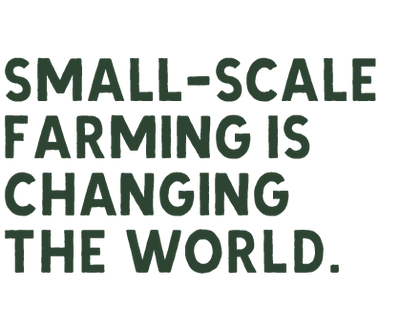Written by Nancy Matsumo
Photographed by Jennifer Hibberd
"I want the roots of my tomatoes to reach deep down into the ground to get nutrients, and get water from the sky. "
For me, a visitor from the city, the scene—radiant blue sky, June-lush grass and a restored nineteenth-century barn—is one of bucolic, timeless beauty. But I know that for my hosts, it is a rare moment of downtime on this 40-acre regenerative farm. Fifteen months of lockdowns with no childcare has isolated the family in its bubble and put a premium on every moment of the day. “If we, as farmers, got COVID because our kid was in daycare, our farm would be wiped out for the year,” says Brenda. “We had to be in total lockdown.” The eight-hour-a-day, five-day workweek she and Skyler anticipated having during the 2020 planting season suddenly turned into a six-hour-a-day, three-day workweek. “I nearly panicked,” Brenda recalls.
“How can I make a one-acre market garden work on three days a week?” The answer was to become “hyper efficient,” one parent rushing to complete a long list of tasks as soon as the other returned from the fields to take over childcare duties. Things eased up that summer once Brenda was able to hire a teenage employee through the Canadian government’s national summer jobs program. This year, Emma is a little older and can spend a bit more time in the fields.
After 13 years on the farm, the pandemic is just one more challenge for Brenda to weather on her path as a farmer. Her goal: to make a living off the land while increasing the biodiversity in her fields, pond and atmosphere surrounding the area. While she is exactly where she feels she should be, this is hardly the future she imagined for herself, growing up in Edmonton, Alberta, as a self-described “indoor child” who played piano and read books.
“I had no ties to agriculture, I was not interested in the outdoors and I did not like insects,” she says. The daughter of a lab technician and a mechanical engineer, she studied biochemistry and pharmacology at university and landed in Toronto working first for a mutual fund company, then a credit rating agency, analyzing data. But it was not her true calling. When she was let go in the wake of the 2008 financial crisis, Hsueh recalls, “I felt liberated.”
An interest in social justice movements fostered by her Bible study group led to an awareness of how the global agricultural-industrial-food complex fosters food inequity, and a desire to forge a more just system. At first, she thought she might end up working for a not-for-profit organization promoting food security and food sovereignty. But after spending a summer at Everdale, a community teaching farm in Hillsburgh, Ontario, she discovered that she loved planting, tending and harvesting—“it was a revelation to me,” she recalls.
The work suited her curious mind. “You can’t get bored farming,” she explains. “There’s always something new, some problem to be solved. There’s a lot of rote stuff, like weeding, but you run the system, you get to choose how long you spend at any particular task, and you have to observe [nature]. It’s a combination of having control and having no control.” Seeds that are not viable, or drought, she notes, are things she can’t control. For the farmer, troubleshooting becomes a way of life.
***





